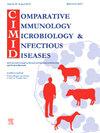不同来源单核细胞增生李斯特菌的血清分型、基因分型、病毒分型和抗生素敏感性
IF 2
3区 农林科学
Q4 IMMUNOLOGY
Comparative Immunology Microbiology and Infectious Diseases
Pub Date : 2025-02-03
DOI:10.1016/j.cimid.2025.102314
引用次数: 0
摘要
本研究旨在对从不同来源分离的单核细胞增生李斯特菌进行血清分型、基因分型、各种毒力基因测定和抗生素敏感性研究。为此,共70个 L。其中鸡22株,鱼20株,羊18株,牛10株。采用聚合酶链式反应(PCR)进行血清分型和毒力基因分析,并采用肠杆菌重复基因间一致性(ERIC)-PCR进行基因分型。此外,采用纸片扩散法测定了菌株对9种不同抗生素的敏感性。血清分型结果显示,单核增生乳杆菌分离株中检出最多的血清组为1/2a-3a(44.3% %),检出最少的血清组为1/2b-3b-7(11.4% %)。ERIC-PCR结果共显示18种不同的模式。所有菌株均检测出inlA、inlB、inlC、iap、prfA、actA、hly、plcA、plcB和mpl毒力基因阳性。actA基因在分离株中的流行率为70 %。检出对6种抗生素耐药,其中对oxacillin(80 %)和环丙沙星(65.7 %)耐药较高。单核增生乳杆菌多药耐药率为28.5 %(20/70)。总之,根据不同来源单核增生乳杆菌分离株的毒力基因流行率、血清群分布、高遗传异质性和抗生素耐药谱等数据,本研究表明,这些来源可能构成潜在的健康风险。本文章由计算机程序翻译,如有差异,请以英文原文为准。
Listeria monocytogenes from different sources: The serotyping, genotyping, virulotyping, and antibiotic susceptibilities of the recovered isolates
It was aimed at serotyping, genotyping, determining various virulence genes, and investigating antibiotic susceptibilities of Listeria monocytogenes isolates recovered from different sources in the current study. For this purpose, a total of 70 L. monocytogenes isolates including 22 chicken, 20 fish, 18 sheep, and 10 cattle origin were used. Polymerase Chain Reaction (PCR) was performed for serotyping and analysis of virulence genes of the isolates, and also Enterobacterial Repetitive Intergenic Consensus (ERIC)-PCR was performed for the genotyping. In addition, it was determined the susceptibilities of the isolates against nine different antibiotics via the disk diffusion method. As a result of serotyping, the most detected serogroup in analyzed L. monocytogenes isolates was 1/2a-3a (44.3 %), and but the least detected serogroup 1/2b-3b-7 (11.4 %). ERIC-PCR results revealed a total of 18 different patterns. All isolates were positive for the presence of inlA, inlB, inlC, iap, prfA, actA, hly, plcA, plcB and mpl virulence genes tested. The prevalence of the actA gene in isolates was determined as 70 %. Antibiotic resistance was detected against six antibiotics, and high resistance to oxacillin (80 %) and ciprofloxacin (65.7 %) in the isolates. Furthermore, the rate of multi-drug resistance in L. monocytogenes isolates was 28.5 % (20/70). In conclusion, the present study showed that the sources may pose a potential health risk, according to obtained data on the virulence gene prevalence, serogroup distribution, high genetic heterogeneity, and antibiotic resistance profiles of L. monocytogenes isolates from different sources.
求助全文
通过发布文献求助,成功后即可免费获取论文全文。
去求助
来源期刊
CiteScore
4.60
自引率
0.00%
发文量
102
审稿时长
40 days
期刊介绍:
Comparative Immunology, Microbiology & Infectious Diseases aims to respond to the concept of "One Medicine" and to provide a venue for scientific exchange. Based on the concept of "Comparative Medicine" interdisciplinary cooperation between specialists in human and animal medicine is of mutual interest and benefit. Therefore, there is need to combine the respective interest of physicians, veterinarians and other health professionals for comparative studies relevant to either human or animal medicine .
The journal is open to subjects of common interest related to the immunology, immunopathology, microbiology, parasitology and epidemiology of human and animal infectious diseases, especially zoonotic infections, and animal models of human infectious diseases. The role of environmental factors in disease emergence is emphasized. CIMID is mainly focusing on applied veterinary and human medicine rather than on fundamental experimental research.

 求助内容:
求助内容: 应助结果提醒方式:
应助结果提醒方式:


